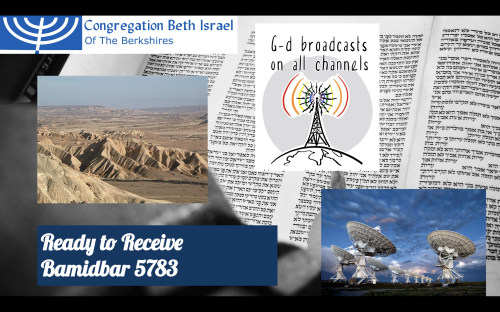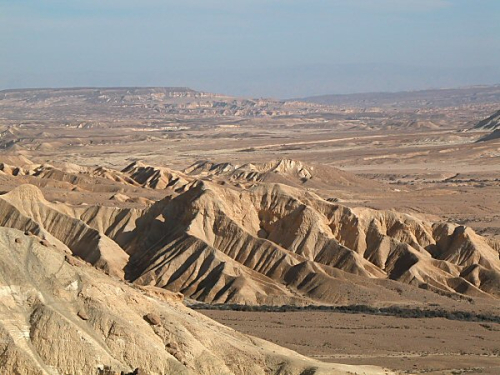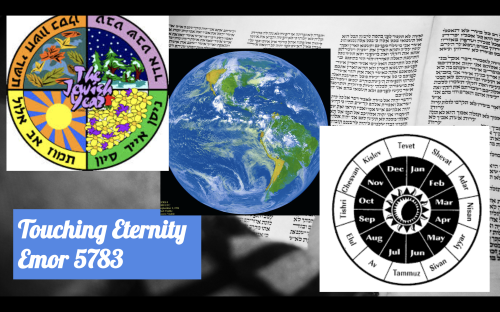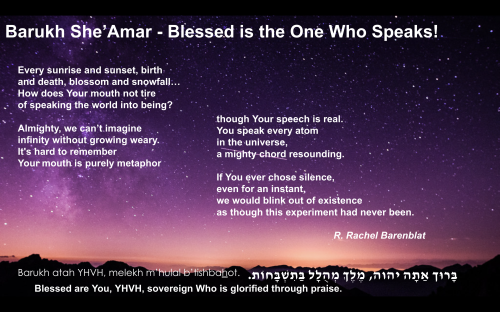Rachel Barenblat's Blog, page 18
July 21, 2023
If We Build: D'varim 5783
This is the d'varling I offered at Bayit's Scholar-In-Residence weekend at the Jacksonville Jewish Center.
It���s Shabbat Hazon, the ���Shabbat of Vision.��� This Shabbat gets its name from tomorrow morning���s Haftarah, in which Isaiah describes a vision of calamities that will befall Jerusalem and the Jewish people. Sure enough, we���re approaching the end of the Three Weeks leading to Tisha b���Av. If this is the Shabbat of Vision, it���s easy to see what���s coming: the fall of the Temple.
Not all Jews deeply feel Tisha b'Av, or mourn the destruction of the Temple, but the fall of the Temple remains the quintessential Jewish tragedy of loss and exile. And yet that hurban ��� that destruction ��� enabled the birth of rabbinic Judaism. Our forebears wrote the Mishnah precisely to preserve memory of what had been and to start rethinking what had been.They took the foundations of the Judaism that had come before, and began to build something new.
Later, in the conversations that became Gemara, the scaffolding of construction rose higher and stretched more broadly. And then others built on those foundations. Today we inhabit a Judaism of so deliciously many rooms! Jewish life and practice now take some forms that our ancestors couldn���t have imagined. But all are built on the foundations we inherited from our forebears. They built the Judaism that their moment needed, and so too do we.
The destruction of the Temple is foundational for the Jewish people not only because it sent us into Diaspora all over the world. It���s foundational because it laid down the principle on which Judaism as we know it continues to unfold: we all need to be builders. The Jewish future is always under construction. That���s the founding principle of Bayit.
In Talmud we read:
Wise students increase shalom in the world, as it is said: ���And all your children shall be taught of God, and great shall be the shalom of your children��� (Isaiah 54:13). Don���t read it as ���your children,��� [banayikh], but ���your builders��� [bonayikh]. ( Brakhot 64a )
It���s our job to increase shalom in the world: not just ���peace,��� but shleimut ��� wholeness, completeness. No one is a spectator to this holy calling. All of us are called to take up our tools and keep building Judaism. That���s one of our core values at Bayit, and as we say in Texas where I grew up, ���Y���all means all.��� All ages, all gender expressions and sexual orientations, all races and ethnicities, all branches of Judaism, clergy and laypeople, rationalists and mystics.
At Bayit we create and curate meaningful tools for building the Jewish future. Like our forebears, we remix tradition with innovation, what���s been with what���s next. Some of our ���builds��� are new books, or new prayers, or new practices. Some are games ��� you���ll get a taste of that tomorrow at Shabbat lunch. All of our ���builds��� seek to engage in new ways or deeper ways, with a first-hand sense of participation and investment in the experience.
How we build is as important as what we build. Building the Jewish future is an iterative process. We try something new. Measure whether it worked. (What does it mean for a prayer or a ritual or a game to ���work,��� anyway?) We get feedback. We tweak and improve. And then we try again. You could call this design thinking, or research and development. I call it fun.
Does it feel weird to be thinking about fun on the cusp of Tisha b���Av? Maybe a better word is nourishing. Even when what we���re building is new liturgy or updated ritual for Tisha b���Av ��� like collaboratively writing the text we called Megillat Covid during the early months of the pandemic, or setting an Amanda Gorman poem to Eikha trope ��� there���s shleimut in doing it.
There���s shleimut in part because we���re building together. In our Liturgical Arts Working Group (a creative collaborative of writers, artists, and liturgists) we���ve got Reform Jews and Orthodox Jews, clergy and laypeople, spanning the continent. Together we���re more than the sum of our parts, and together we can build in ways that none of us could���ve done alone.
The Judaism of the future needs all of us, in all that we are and all that we can become. That���s one of my favorite ways to understand the teaching from Torah that we���re made in God���s image (Gen. 1:26). Each of our souls is a facet of that ineffable Whole we name as God, which means the only way for the image of God to be complete is for all of us to build together.
And a Judaism of shleimut asks us to be authentic. In spiritual life and ethical life, the things we do and the way we do them, we need to bring our whole selves to the table. The work of building Judaism requires us to be real with each other, with our traditions, and with our Source. Otherwise what we���re building would rest on flimsy foundations.
The Judaism of the future won���t look exactly like the Judaism of today, any more than what we do looks exactly like the Judaism of 800 or 2,000 years ago. With all due respect to the great Rabbi Moses Shreiber of Pressburg, the Hatam Sofer (d. 1839) who claimed in a streak of preservationism that anything new in Judaism is automatically forbidden, change has always been built into Judaism. When the Temple fell, we took broken pieces of tradition as we���d known it and we built something beautiful and new. Even the Temples were a re-framing of what had come before, a traveling Mishkan in the desert, which replaced the stone altars of Abraham, Isaac and Jacob.
Rabbi Isaac Luria (d.1572) taught that when God began to create, God���s infinite light streamed into creation. The ���vessels��� that were meant to hold that light were too fragile, and they shattered. The world as we know it is full of the broken shards of those original vessels, concealing sparks of creation���s original light. Our job as Jews ��� and I would say, our job as human beings ��� is to repair the world���s broken pieces and uplift those holy sparks. That was the original meaning of tikkun olam: literally, taking up our tools and repairing our broken world.
It���s Shabbat Hazon. When we look around, we can see plenty of brokenness.
But brokenness isn���t the end of the story. The very fact of Judaism itself proves that, to the contrary, it���s only the beginning. It���s an invitation to create something new, and a spiritual mandate to do so together. On our spiritual calendar, Tisha b���Av next week begins the seven-week runway to Rosh Hashanah and the infinite potential inherent in every new year. The Judaism of tomorrow will be what we make it, and especially on this Shabbat of Vision, I can���t wait to see what we���ll build together next.
To remix Theodore Herzl (the ���father��� of modern political Zionism) with the 1989 Kevin Costner classic Field of Dreams, if we build it, it is no dream.
July 14, 2023
The Journeys: Matot-Masei 5783 / 2023
This week���s Torah portion, Matot-Masei, begins, ���These are the journeys of the children of Israel������ (Num. 33:1) Torah spends many verses listing the 42 places where we went or stopped or camped over forty years. (Num. 33:1-37) In a 12th-century collection of midrash on the book of Numbers, our sages compare Torah's recounting of our journeys to the parable of a king whose child fell ill:
[The king] brought him to a certain place to heal him. When they returned, his father began recounting the stages, ���Here we slept. Here we cooled off. Here you had a headache....��� (Bamidbar Rabbah 23:3) I like the image of God as the parent who remembers every moment, and the chronicle of our journey as a reminder that the One we name as God is with us everywhere along the way.
As a speculative fiction fan of a certain age the number 42 makes me think of Douglas Adams' Hitchhiker's Guide to the Galaxy, in which the number 42 connotes, "life, the universe, and everything." Another interpretation: as R. Laura Duhan Kaplan notes, there are 42 words in the v'ahavta, the prayer that instructs us "to love God when we come and when we go and when we rest."
To the mystic known as the Baal Shem Tov, Torah's list of stops along our journey is a metaphor for the journey of an individual soul. The forty-two stops evoke the twists and turns of every human life: leaving Mitzrayim / places of constriction, seeking sustenance and purpose and our hopes fulfilled. And for us as for our ancient ancestors, the trajectory of the journey probably won't be linear.
For us as for our spiritual ancestors, the journey might feel tangled. A journey that we might imagine should be brief or simple can take a lifetime. If you���ve ever thought, ���Haven���t I been here before? Didn���t I already face this issue, didn���t I already do this work?��� ��� you���re not alone. Any therapists in the room are nodding right about now. The work of becoming is never done.
The work of living up to our best selves, refining our best qualities (from lovingkindness to ethical strength to presence), acting with integrity, learning from our mis-steps is never done. It's almost as though the journey itself is the point, and the Land of Promise is our ethical north star that guides us.toward building a world in which every human being enjoys full human rights and dignity.
R. Alan Lew writes about how we bring ourselves to the same unresolved issues over and over again. I see the same kind of patterns in our national political life. (Today's wave of anti-trans legislation in many states mirrors the "gay panic" of the 1980s.) Are we just going in circles? I prefer to hope that we can make our trajectory go up even as cycles repeat, like the ramp inside the Guggenheim.
The Hasidic master R. Levi Yitzchak of Berditchev teaches that all of our journeys come from God for the sake of lifting up sparks. Our mystics imagined that when God first set out to create, God's infinite light streamed into a world that was too fragile to hold it, so creation's "vessels" shattered. There's a primordial brokenness -- and also primordial sparks of supernal light for us to find and uplift.
Our job is to cultivate the inner qualities that the fallen sparks need in order to be uplifted. We need empathy, we need care for the other, so we can take care of the broken places in the way that they need. Ultimately, the purpose of our journeying is to effect yetziah -- going-forth, Exodus from tight straits -- not just for us, but for the holy sparks in the broken places. For the whole broken world.
Okay, these are sparklers, not holy sparks. But for me the image evokes the sparks in everything.
If our journeying is only for the sake of our own needs and our own growth, we're doing it wrong. Don't get me wrong: our own growth does matter. Becoming our best selves does matter. But not for the sake of our own greatness. We strive toward becoming the best "us" we can be so that we can help others. Feed the hungry. End poverty. Uplift human rights and dignity. Lift all the sparks.
And that includes the sparks we find beneath the shards in life's broken places. Enter the Jewish calendar. We���re in the Three Weeks between 17 Tammuz when we remember the first cracks in Jerusalem���s city walls, and Tisha b���Av when we remember destruction and face what's broken. On Tisha b���Av we���ll begin a seven-week journey of preparing ourselves to begin the new Jewish year.
The Jewish calendar is saying: what feels broken or precarious? The calendar is saying: we need to see what���s broken in order to mend it; we need to feel our losses in order to move through them. As R. David Markus writes, We need to see where we've been in order to know where we're going. And what better time to look back on the twists and turns of our path than now, approaching a new year?
The journey of a lifetime isn���t linear. The journey of spiritual growth: not linear. The journey of a community or a nation toward living up to its highest ideals: not linear. Progress toward justice and human dignity for people of every race, religion, origin, sexual orientation, gender expression: not linear. The human journey is rarely linear: not for our ancestors in Torah, nor for us now.
We may feel lost or stuck; our ancestors did too. We may be unsure how to get from here to the land of promise; our ancestors were too. Maybe we're frustrated to be fighting to regain rights and safety we used to be able to take for granted; nu, spiritually we're right on time to face life's broken places. And wherever our journeys take us, we uplift every spark... until we've lifted up the world.
Shared with deep gratitude to the Bayit board of directors for learning together each week.
This is the d'varling I offered at Kabbalat Shabbat services at Congregation Beth Israel of the Berkshires (cross-posted to the From the Rabbi blog.)
June 16, 2023
Taking Turns Holding Hope: Shlach 5783
This week���s parsha, Shlach, holds the story of the scouts. God tells Moses to send scouts to explore the land of promise, one from each tribe. Twelve are chosen. When they reach the land, they find grapes so big that they require two men and a carrying-frame. Upon returning, ten of the scouts say: there are giants there. We felt like grasshoppers. We can���t do this..
Joshua and Caleb argue otherwise. They plead, ���don���t be afraid!��� (Num. 14:9) But the ten who���ve lost faith carry the day. And their loss of faith is contagious. ���If only we had died in Egypt!��� the people shout. ���Or if only we might die in this wilderness!��� The children of Israel don���t have hope that anything will ever become better than they���ve known it to be so far.
And God says, ���fine, you know what: if you don���t trust in Me even after everything you���ve just seen, the Exodus, the signs and wonders, you can stay here in the desert for forty more years. When this generation is gone, then I���ll lead the children of Israel into the land of promise. But you are clearly too scarred by the traumas you���ve endured. You don���t get to make it there.���
This year I���m feeling empathy for the minyan of ten who didn���t think they could do it, the ones who said, ���I don���t have it in me, and I can���t believe that I ever will. This is too big. I���ve spent my whole life slaving to meet Pharaoh���s demands, or to try to feed my family in traumatic circumstances. All I can see ahead is more grind, and I���ve lost heart for the struggle.���
I suspect we���ve all felt that way. I don���t have it in me, and I can���t believe that I ever will. All I can see ahead is more grind, and I���ve lost heart. Loss can put us in that place. Or depression. Or grief, or overwhelm, or illness, or disappointment ��� you don���t need me to count the ways. The scouts get a bad rap for losing faith, but I suspect we can all relate to them.
There���s nothing wrong with fear or doubt. ���Spirituality��� that pretends we never have those feelings is at best incomplete. I don���t think any life is entirely devoid of those ��� not if we���re paying attention and being real. The place where the scouts got themselves into trouble, I think, was giving in to despair. As Reb Nachman of Breslov teaches, ���it is forbidden to despair.���
It���s forbidden because despair means giving up on God���s capacity to lift us out of life���s narrow places. If the ���G-word��� doesn���t work for you, try: despair is giving up on the possibility of change, the possibility of hope, the possibility of anything ever being better than this. It���s noteworthy that Reb Nachman was depressive. Was he giving the advice he himself most needed to hear?
Enter Caleb and Joshua: the scouts who say, ���wait, we can do this.��� Sometimes we need to hear that the future can be more than whatever limitations are currently constraining our hearts. When we���re in the narrow place of not being able to see a way out, we need someone to remind us that change is possible and that the future can be sweeter than we can currently see.
These roles ��� the person who despairs; the person who offers hope for better ��� aren���t innate. We take turns. Sometimes I'm the one with the reminder that life can be better than we fear, and sometimes I���m the one who needs to be reminded. All of us are the weary souls too demoralized to imagine better, and all of us are the dreamers who can see a better world.
When we despair we need someone to walk with us, to feel with us, and to remind us that when we feel most stuck, change can be waiting in the wings ��� even (or especially) if we can���t see it. I think about how Isaac might have felt during the akedah: bound, immobile, his father���s knife raised over him ��� not yet knowing there was a ram waiting just outside the frame.
To be clear: the loved one who is ill may not be cured. The grief that comes with loss can���t be short-circuited. Sometimes what���s broken can���t be repaired. But change is always possible, even if that change is ���only��� internal. Honestly, internal change can be��� everything. Maybe not what is, but how we feel about what is. How we experience what is, and how we respond.
The scouts represent the Twelve Tribes of Israel. Our mystics associate the tribes with different qualities, weaknesses, and strengths. The cleric, the judge, the scholar, the sufferer: each tribe is linked with a different archetype or journey. In today���s world, I don���t think these energies define us. I suspect we each resonate with different core qualities at different times.
The tribe of Judah, Caleb���s ancestor, is associated with leadership and with gratitude (hoda���ah). And Joshua descends from Ephraim, who is associated with transformation and with thriving even in tight places. These same qualities can fuel us when we accompany each other into tough times, and when we hold on to hope for those who can���t feel it right now themselves.
I���ve come to see God���s threat of a lifetime in the wilderness not as prescriptive but as descriptive. It���s not that our lack of faith is punished by a lifetime of suffering. Rather: when we���re mired in despair, that���s what our lived experience becomes. Our work is to transform the prospect of a lifetime of wilderness wandering into a sacred journey of becoming.
And we can���t do that alone. We all have moments of feeling like grasshoppers faced with giants; we need each other. When we���re in this together the fact of the wilderness is the same, but the internal dynamics and lived experience can be different. And when we hold hope for each other, we keep open the door to possibility, and the promise of blessing, and change.
This is the d'varling that I offered at Congregation Beth Israel of the Berkshires (cross-posted to the From the Rabbi blog.)
June 12, 2023
Fifty truths
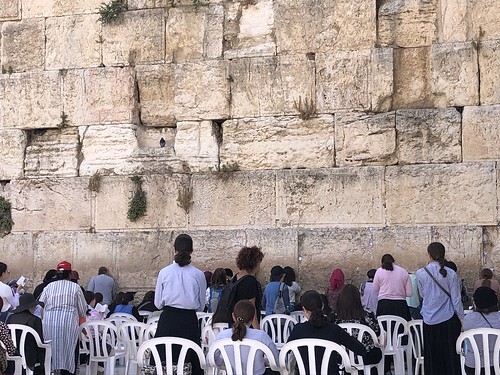
1. This place is where the Jewish story began.
2. There are so many essays I want to write, but every sentence needs a page of footnotes.
3. Every time the kaleidoscope of my heart turns, the pieces of this place make a new pattern: breathtaking and intricate, complicated and real.
4. My place in the chain of generations: twenty-five years ago I visited the Western Wall with my mother (may her memory be a blessing), and now I have done so with my son.
5. In Tzfat, many doors are painted blue to offer mystical protection. Also walls, ceilings, headstones. Blue evokes tchelet, the heavens and the sea, the vision of sapphire floor beneath God's throne.
6. There are so many broken shards here, and so many hidden sparks to uplift.
7. I do not believe that God has a physical address. God's presence goes with us everywhere, in our wholeness and in our exile.
8. We've been directing our hearts and our prayers toward or through this place for thousands of years. That leaves a spiritual imprint both on the place and on us.
9. Those two truths might seem contradictory, but they're not.
10. I had forgotten how powerful it can be to glimpse parts of our sacred story in the archeological record. To walk where our spiritual ancestors walked. To feel we are a part of their story.
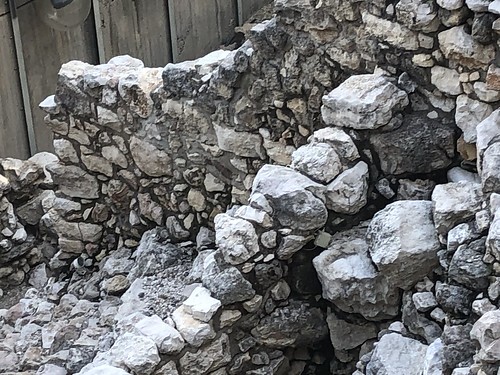
11. To me this place is a miracle, a refracting lens for emotion and for spirit, a heartbreak.
12. Jerusalem is the only city where I've ever lived on my own, rather than with my parents (now gone) or my spouse (now no longer my spouse) or my child.
13. The Romans slaughtered us for not bowing to Rome. The Crusaders slaughtered us for not converting. Hitler slaughtered us not because of our beliefs, but because he saw us as subhuman.
14. I love this place independent of that history, but the history is also always present.
15. The stories in Tanakh (the Hebrew scriptures) land differently when one can see the topography of spring and desert, valley and hill.
16. Even the names used for places, neighborhoods, and structures here convey identity and politics. Settlement or neighborhood? Security fence or separation wall?
17. To really describe this place of promise, maybe I would need God's voice: conveying all possible meanings and nuances at once.
18. At the Great Mosque in Ramle one might sit on the floor, press palms to the lush carpet, and ask God for peace and wholeness for this place and its peoples. Of course, one might do that anywhere.
19. Everyone is on top of each other here. Different communities might be only a stone's throw apart. I've known that for years, but when I'm away I forget just how true it is.
20. In her poem "Jerusalem," the poet Naomi Shihab Nye travels from "I'm not interested in who suffered the most" to "it's late but everything comes next."
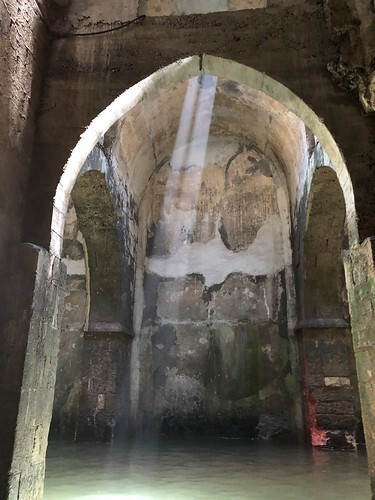
21. In the Pool of the Arches, an 8th century underground cistern, shafts of light pour down from skylights onto still waters plied by small rowboats.
22. The moniker the White City has nothing to do with the color of the buildings, though I still think it could.
23. Foods to which many nations lay claim, a non-exhaustive list: falafel, hummus, that chopped salad of cucumbers and tomatoes.
24. It's hard to stop wondering which different choices could have led the peoples of this place to a just and lasting peace.
25. The name Tel Aviv simultaneously evokes both past (a tel is a manmade hill, created through thousands of years of human habitation) and future (aviv means spring).
26. I thrill at the sight of bougainvillea and oleander, fig trees and date palms, pomegranate trees and grape vines, even the purple thistles that bring a spot of color to the desert scrub.
27. How good are your flavors of ice cream, O Jacob; your mint-lemonade with arak, O Israel!
28. Doris Haifawi, a Christian Arab Palestinian Israeli woman who claims all of those adjectives and who welcomes visitors into her home, wears the kind of fancy slip-on sandals my mother used to love.
29. During the First Rebellion against Rome, Yifat was reduced to rubble. Nearby Tzippori surrendered, which is how Judah ha-Nasi survived to write down the Mishna that became the heart of Talmud.
30. I never liked the story of the rebels at Masada who chose suicide over defeat, but now I realize they were at the end of a failed rebellion: they knew what had become of their fellow Jews.
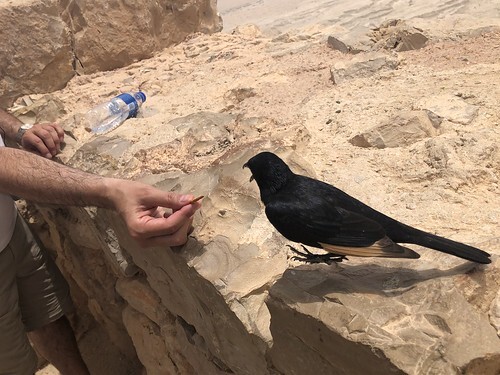
31. The black birds with orange streaks on their wings are a kind of grackle, and they like pretzels.
32. Every day that I am here in this place, I thank God that I am here. Every day that I am here in this place, I remember that there are people who yearn to be here and cannot be.
33. I love the fact that after centuries of being "only" a tongue of sacred text study, our holy language is again spoken in streets and marketplaces.
34. So much water is diverted from the Jordan to sustain the peoples of this place that the river is now small, like the Rio Grande. At Qasr al-Yahud the water is cold even on a 110-degree day.
35. King Hezekiah's underground water tunnel, chiseled into bedrock in the late 8th century BCE, is a good place in which to pray Ps. 118:5: ���������������������������� ������������������ ������������ / "from the narrow place I called to You!"
36. The many small cats at Kibbutz Degania Bet near the Kinneret are extremely friendly, but I wouldn't advise petting the street cats in the Old City of Jerusalem.
37. Riding an electric scooter along the bike path between Tel Aviv and Yafo at night is both terrifying and exhilarating.
38. There are parts of the Judaean desert that seem so barren and windswept, they evoke the way I imagine I might feel on the surface of Mars.
39. Things that call to me in the market, a non-exhaustive list: olives, apricots, fuzzy green almonds, whole fish on ice, burlap bags of spices and tea, round cakes of halvah sparkling with pistachios.
40. I love to hear the muezzin's call echoing from every minaret, the tolling of church bells, the happy songs of the Breslover Hasidim, Hebrew songs and prayer accompanied by acoustic guitar.
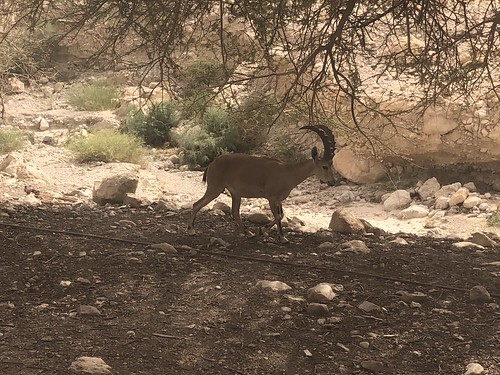
41. The ibexes at Ein Gedi are almost the same color as the land. Some of them climb trees.
42. Every single time I enter Jerusalem after being away, I weep.
43. Rosemary grows into bushy shrubs here. I want to crawl into one and make a home there.
44. 187 days of Arabic on Duolingo are not enough.
45. On this trip, the only person who hassles me about wearing a kippah is an older lady with a Russian accent, loading purchases from a homegoods store into the trunk of her car.
46. I wish every breakfast of my life could include burekas, hummus with cucumbers, labneh and zaatar, and watermelon with feta. Some of these are easier to replicate at home than others.
47. I love seeing mezuzot on (almost) every door.
48. The first thing that breaks me at Yad Vashem is the Dan Pagis poem Written in pencil in the sealed freight car. The facts are too terrible: my heart shutters. But poetry slips in through the cracks.
49. The moment I take my pick to the soft earth in Tel Maresha, I find potsherds, fragments of charcoal, and bits of bone. Remnants of ordinary life from the time of the Maccabees, 2200 years ago.
50. I fly home with the dust of the land under my fingernails.
May 26, 2023
Revelation
One year ago:
a hospital room
on the seventh floor.
I stood for Hallel
in grippy socks
and thin johnny
my hand adorned
with a heparin drip
on a wheeled pole,
leadwires and stickers
reporting on
my unruly heart.
Most days
I forget.
Mind busied
with counting
how many meetings
are scheduled.
Did I make room
in the car
for my son's double bass,
is there milk
in the house
for tomorrow's cereal?
But then
your voice knocks
and my heart wakes,
remembering --
being alive
is revelation.
May 19, 2023
Ready to Receive: Bamidbar 2023 / 5783
This Shabbat we begin reading the book of Numbers -- in Hebrew, Bamidbar. That's the name given both to the book of Numbers, and to this week's Torah portion, which begins:
���������������������� ��������������''�� ���������������������� ������������������������ �������������� ������������������ ��������������
And God spoke to Moshe in the wilderness of Sinai, in the tent of meeting... (Numbers 1:1)
The wilderness of Sinai.
Bamidbar means in the wilderness. Midbar, wilderness, is related to m'daber, when someone speaks. The wilderness is where we hear the voice of God. And the quintessential example of that is Sinai, where we received the revelation of Torah long ago in a time beyond time; when we continue to receive Torah even now, in our day. You might have noticed that I just scrambled place and time. Hold that thought.
So we're in the wilderness of Sinai. Torah also locates this in the Ohel Mo'ed. When the word mo'ed appears with ohel, tent, it's usually translated as Meeting. This is the Tent of Meeting, the place where community comes together. But on its own, mo'ed means season, appointed place or time. As in the ������������������ ��������������''�� / mo'adei YHVH / God's "fixed times," that we just read about in Torah. (Lev. 23:2)
Shabbat is first among those fixed or appointed times. Every seventh day we rest, as God rested; we live as-if the world were already redeemed; we taste eternity. And then Torah lists the other Biblical moadim, the oldest among our festivals. Pesach, and Shavuot, and Sukkot, and the Days of Awe. These are our earliest moadim, the most ancient appointed times of connection with our Source.
"And God spoke to Moshe in the wilderness of Sinai," -- the place of revelation; "in the ohel mo'ed," -- both the tent of community meeting, and a sacred fixed point in time. That's where this verse places us: in the wilderness, in the middle of nowhere -- which is where God speaks (or maybe where we hear), where we're receptive as satellite dishes, at the nexus of holy space and holy time.
I kind of imagine our souls at Sinai as a human version of the Very Large Array.
In the Midrash we read:
Why [was Torah given] in the wilderness of Sinai? Our sages taught: Torah was given with the accompaniment of three things: fire, water, and wilderness... Why was the giving of Torah marked by these three? To show that as these are free to all, so too the words of Torah are free. Anyone who does not make oneself as open (hefker / ownerless) as the wilderness is not able to acquire wisdom and Torah.
(Midrash Numbers Rabbah 1:7)
In order to receive Torah, we too need to become hefker, ownerless. Torah was given at Sinai because in antiquity "the wilderness" had no owner. Because it was hefker, it belonged equally to everyone. Hefker is a legal term, often used in the context of "land that is declared ownerless by a beit din." But I'm most interested in what it means for us spiritually, what it teaches us about how to prepare for revelation.
Becoming hefker means not letting ourselves be "owned" by our achievements. Maybe we become so attached to a job or a role that it begins to "own" our sense of self. Or our sense of self gets tied up in whether or not we get a certain job,��� and then what happens at retirement? When we define ourselves through what we accomplish and how others see us, that can get in the way of receiving Torah.
Hefker means not letting ourselves be "owned" by our attachments. It's so easy to get attached in our relationship to possessions. What kind of car we drive, or maybe we've chosen not to drive at all. Where we get our clothing, whether "I wear name brands" or "I only buy secondhand." When we define ourselves through our stuff or lack thereof, that can get in the way of receiving Torah, too.
Honestly, if we define ourselves wholly through our emotional "stuff," our baggage or our traumas or the harms we've endured, I think that can get in the way of receiving Torah too. Let me be clear: I'm not saying that having experienced trauma blocks the flow of revelation! I'm saying that when we get too attached to any piece of our identity, we block ourselves from being open to something new.
And no aspect of our identity makes us "worthy" of receiving Torah. The worth of a human soul is both infinite and innate. We merit the receiving of Torah because that's our covenant. God gives us Torah, and we aspire to live a life of meaning through the mitzvot, the commandments, contained therein. We merit the receiving of Torah every time we say yes to that covenant, to living our Jewish values.
On some level, Torah is ours even if we're full of ourselves. But as we ready ourselves for Shavuot, for standing again at Sinai, for receiving Torah anew, I'm moved by that midrash from Numbers Rabbah about becoming hefker. In some way, becoming hefker feels like a call to become more simply ourselves, unencumbered by roles or expectations. It reminds me of the Zen parable of Nan-in and the teacup.
There was a Japanese Zen master named Nan-in who lived during the Meiji era (1868-1912). During his days as a teacher, he was visited by a university professor curious about Zen.
Being polite, Nan-in served the professor a cup of tea.
As he poured, the professor���s cup became full, but Nan-in kept on pouring. As the professor watched the cup overflow, he could no longer contain himself and said, ���It is overfull. No more will go in!���
Nan-in turned to the professor and said, ���Like the cup, you are too full of your own opinions and speculations. How can I show you Zen unless you first empty your cup?���
Like that professor, we need to empty our preconceptions, our over-attachments, before we can receive Torah anew. This is big spiritual work. That's why our tradition gives us the seven weeks of the Omer between Pesach and Shavuot! And this is not just for priests (who don't exist anymore), or rabbis, or sages, or Hebrew-speakers, or people in power. The Midrash reminds us of that, too.
���Rabbi Yochanan said: When God���s voice came forth at Mt. Sinai, it divided itself into 70 human languages, so that the whole world might understand it. All at Mt. Sinai, young and old, women, children, and infants according to their ability to understand. Moses too, understood only according to his capacity, as it is said (Ex. 19:19), ���Moses spoke and God answered him with a voice.��� With a voice that Moses could hear.���
(Midrash Exodus Rabbah)
Torah flowed in a way that all the world could understand. And God's "voice" -- which of course isn't a literal voice -- is pitched in a way that can reach us where we are. Torah reaches every person in accordance with our capability to hear. Torah's like the manna that fell in the wilderness. Midrash teaches that each person tasted something different, depending on what they needed:
The infants in accordance with their faculties; just as this infant would suckle at his mother's breasts, so he would taste it; as it is stated: "And its taste was like that of a cake (leshad) baked with oil.��� [This is a pun on shadayim, breasts.]
And the youths in accordance with their faculties, as it is stated: "My bread also which I gave you, fine flour, and oil, and honey, wherewith I fed you" (Yechezkel 16:18).
And the adults in accordance with their faculties, as it is stated: "And the taste of it was like wafers made with honey.��� Just as the manna, each person tasted it in accordance with his faculties, so the commandment, each person heard it in accordance with his faculties.
(Pesikta de-Rav Kahana 12, 25)
Everyone found in the manna what they most needed. Torah is the same way: one text, from which we take away different wisdom depending on who we are, and when and where we are. We find different things in Torah depending on what we need. So... what's the Torah that you most need this year? What's the wisdom, the new interpretation, the deep justice and love that you most need this year?
Image by Steve Silbert.
The divine broadcast continues to sound, and we receive it when and where we are attuned. And one of our tradition's times to "tune in" is in just a few days, when we gather at the foot of the mountain to hear God's voice anew. So get ready to tune the dial on your inner spiritual radio. Or maybe I should say subscribe to God's podcast (or God's TikTok?) because new episodes are dropping all the time.
We're all invited to let go of attachment to stuff or status, role or expectation, because all of those can block our capacity to hear the divine broadcast. We get to drop everything extraneous, and each of us gets to be our purest, most essential self. You'll know best how to embody that change on Thursday afternoon. Some people immerse in a mikvah, some use meditation, some use song.
And then without preconceptions we open our hands and our hearts. We come to the table with an empty teacup, ready to be filled. We open to Torah, to wisdom, to the spiritual sustenance we need.
See y'all at Sinai, real soon.
This is the d'varling that Rabbi Rachel gave at Congregation Beth Israel of the Berkshires (cross-posted to the From the Rabbi blog.)
May 11, 2023
Life lessons
Before I became a rabbi, I worked as an editor. I edited a monthly paper in south county for a few years after my first stint in graduate school (MFA in writing and literature at Bennington.) A good editor, I came to understand, is one who helps a work become the best version of itself: not imposing her own voice, but helping the writer refine their gem in the ways that will most allow it to shine.
Over the last few years I've been bringing that skillset to the publishing work I do at Bayit. Y'all, it is so much fun. I love helping people uncover what's best in their work. I love uplifting voices that move me. (Arguably this is part of why I co-founded a Jewish spiritual innovation incubator in the first place.) I love how together we can bring forward something that is more than the sum of our parts.
About two years ago, a manuscript came our way that piqued my interest. It's by R. Mark Asher Goodman, a rabbi who at the time I only knew over Twitter. His book features Hassidic texts -- many of them translated into English for the first time -- and opens them up for a modern reader with wry and self-deprecating humor, pop culture references, and quotes from the Wu-Tang Clan.
It's called Life Lessons from Recently Dead Rabbis: Hassidut for the People. Would Bayit be interested in publishing this book?
Would we ever.
Introducing... Life Lessons from Recently Dead Rabbis: Hassidut for the People
by R. Mark Asher Goodman; cover art by R. Zac Kamenetz
published by Bayit: Building Jewish
The process of bringing the book to press has taken longer than I thought it would, of course. The last couple of years have been challenging ones. Not just the continuing global pandemic and American political upheaval, but also my father's illness and death, and my heart attack and continuing health quandaries, on top of rabbi-ing and parenting and all the normal things that need to get done.
But it is so worth the wait. Hasidic texts are a particular passion for many of us at Bayit (I've been blogging about them since the early years of Velveteen Rabbi when I was in rabbinical school), so that aspect of the book is already my jam. If you're a longtime reader of Hasidic texts, you'll find familiar kinds of wisdom here -- plus also perhaps some texts from rebbes you haven't encountered before.
If you're new to the Hasidic world, if you can't read Hebrew, even if you're a spiritual seeker with no connection to Judaism at all: wow are you in for a treat. Each chapter contains questions for contemplation, texts in translation, and Mark's commentary. And Mark's voice is unique. Heartfelt and thoughtful, and also sometimes snarky, geeky, and irreverent. These are a few of my favorite things.
I wish I could say we planned to launch on Lag Ba'Omer, the holiday when we light bonfires to represent the fire of mystical Torah wisdom still shedding spiritual light in our day. Truth be told, it was a coincidence of timing and data propagating. Then again, maybe every coincidence is God's hand at work. Who am I to say that this wasn't the Kadosh Baruch Hu pulling some digital strings?
Anyway, you can learn more about the book (and click through to buy a copy, if you're so inclined) on its page on the Bayit website: Life Lessons from Recently Dead Rabbis. And while you're there, I hope you'll click through to see Bayit's whole catalogue, e.g. the other books that we've published and are in the process of publishing. We've been entrusted with some really amazing work. I am so grateful.
Thanks for listening to me kvell about the newest book I've been blessed to midwife into being. If you love the cover of Life Lessons, check out R. Zac Kamenetz's psychedelic portraits of rabbis and rebbes. (And here's a link to his work with Shefa, doing Jewish psychedelic support.) Find author R. Mark Asher Goodman here. And stay tuned for info on Bayit's upcoming books, coming soon.
May 9, 2023
Tears
"I burst into tears the minute I saw the news." I've already heard that this afternoon from more women than I can count.
I want to say first: if reading anything about the E. Jean Carroll case might harm you, maybe because you are a survivor of assault or defamation and this whole news cycle is like salt in a reopened wound, please take care of yourself and click away if you need to.
And if that's not you, and if you are one of the people weeping this afternoon because the jury in the Carroll case found the defendant liable for both battery and defamation --
because of the sheer existential relief of knowing that at least here, at least once, a woman who's been deeply harmed both physically and reputation-wise is believed and is vindicated --
because like so many of us, you've been braced against the fear of yet another news cycle filled with reminders that it doesn't matter to the world if someone touches us without consent, or spreads hateful vitriol and lies in order to discredit us --
because there's a spiritual relief in truth, and in facts, and in justice, especially against the backdrop of years of national gaslighting --
-- if any of this describes you: please know that you're not alone, and I see you, and I am holding you in my heart.
May 6, 2023
Touching Eternity: Emor 5783 / 2023
This week's Torah portion, Emor, gives us a roadmap for the spiritual flow of the Jewish year. First is Shabbes. "On six days work may be done, but on the seventh day there shall be a sabbath of complete rest." (Lev 23:3) Then comes Passover, the Feast of Unleavened Bread. Then the seven weeks of the Omer, the corridor of time we're in right now. Then Shavuot on the 50th day, festival of first fruits.
Then Rosh Hashanah, a day of shofar blasts. Of Yom Kippur, Day of Atonement. Torah says, "������������������������ ������������������������������������ " -- usually translated as "you shall practice self-denial," though I prefer to read it as, "You shall answer your soul." Four days later, Torah says, it's time for Sukkot. Build a sukkah and live in it. Gather lulav and etrog. Rejoice before God for seven days, and the 8th day is a festival day too.
It's an outline of the Jewish spiritual year. Every seventh day, we're supposed to rest. Shabbat is first and foremost: the basic unit of Jewish time is six days of regular week and a seventh day of Shabbat. And then we move from liberation to revelation to gratitude. From spring harvest (Pesach) to summer harvest (Shavuot) to the Days of Awe and the fall harvest (Sukkot.) That's the cycle of our year.
There are a few holidays that aren't here. Tu BiShvat, the new year of the trees. Purim, festival of masks and merriment. Tisha b'Av, when the Temples fell. Chanukah. All of these are post-Biblical. They're from the last couple thousand years, more or less. That makes them positively modern, by Jewish standards! Listed here are the oldest fixed points in the Jewish year, from antiquity to now.
This week's Torah portion reminds me that our holidays aren't wholly separate or discrete. The festivals are connected like pearls on a string. One leads to the next. Notice how the Omer draws a through-line connecting liberation at Pesach with revelation at Shavuot, or how Rosh Hashanah (shofar as spiritual alarm clock) sets up Yom Kippur (answering the call of our souls) which leads to Sukkot.
The festivals connect us with the earth: Passover and Shavuot and Sukkot are all harvest festivals, because in the Mediterranean climate where our tradition originated those are all times of year when things are growing. They connect us with the heavens, too: Pesach and Shavuot fall at full moon, Rosh Hashanah falls at new moon, and of course each week is half of the moon's waxing or waning.
They connect us with community. In antiquity, the Shalosh Regalim / Three Pilgrimage Festivals (Pesach, Shavuot, and Sukkot) were times of coming-together as a community. Today the Days of Awe and Passover tend to be our big times of convocation. But whether it's three times a year, or twice a year, or every week, these holy times are meant to be celebrated in community, as a community.
And they connect us with our obligation to take care of each other. This week's Torah portion reminds us again that when we harvest, we must set aside grain for "the poor and the stranger," for those who are marginalized. (Lev. 23:22) At Passover we remind ourselves "let all who are hungry, come and eat." At Sukkot, in our rain-prone sukkahs, we rekindle awareness of homelessness and housing insecurity.
The earth, and the stars, and community, and taking care of each other: these are among the most enduring things there are. Empires come and go, and all of these are still here. An individual life has its ups and downs, and all of these are still here. Our festivals connect us with eternity. And I like to hope that even thousands of years from now, maybe orbiting some distant star, they always will.
So notice where we are in the year. Where are we coming from? Where are we going? Take heart in how the Jewish year connects us across both time and space -- with our ancestors and our descendants, and with our fellow Jews everywhere. We're part of something enduring. And may all of this galvanize us in taking care of each other, and of our world, and of our own spiritual lives: now and always.
This is the d'varling that I offered at Congregation Beth Israel of the Berkshires on Shabbat (cross-posted to CBI's From the Rabbi blog.)
May 2, 2023
Barukh She'Amar (2)
Every sunrise and sunset, birth
and death, blossom and snowfall...
How does Your mouth not tire
of speaking the world into being?
Almighty, we can���t imagine
infinity without growing weary.
It's hard to remember
Your mouth is purely metaphor
though Your speech is real.
You speak every atom
in the universe,
a mighty chord resounding.
If You ever chose silence,
even for an instant,
we would blink out of existence
as though this experiment had never been.
R. Rachel Barenblat
This is a revision of a liturgical poem I wrote several years ago. It appears in my book Open My Lips, published by Ben Yehuda Press.
I still love the imagery in the original poem, and the way the cascade of items evokes the constancy of God's speaking the world into being. And... I've found that it's too long for me to regularly use as liturgy.
So here's a shortened version that works better for my current davenen-leadership style. Perhaps it will speak to you, too.
Rachel Barenblat's Blog
- Rachel Barenblat's profile
- 6 followers


